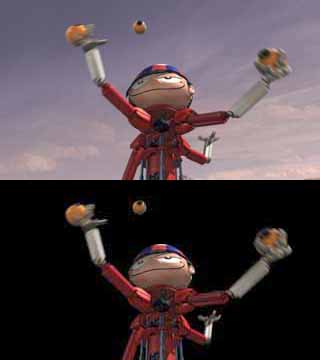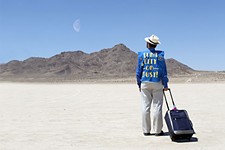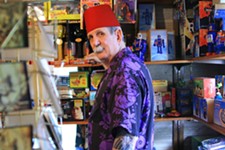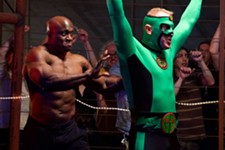Gadgets and Gizmos
From digital derring-do to super sculpey miniatures, imagination turns into mind-blowing matter in Spy Kids 2: The Island of Lost Dreams
By Marc Savlov, Fri., Aug. 9, 2002

More than any other Texas filmmaker working today, Austin's Robert Rodriguez has embraced the digital filmmaking lifestyle, from pre-production to post, and, truth be known, it suits him better than most. Still, bringing the worlds that exist inside Rodriguez's head to life requires expansive (and expensive) teams of digital effects companies from across both country and continent, accompanied by their nondigital counterparts in the fields of prop departments and pre-production concept art.
And far more than in Rodriguez's previous films, the Spy Kids series -- launched with 2000's Spy Kids and followed this week by Spy Kids 2: The Island of Lost Dreams -- relies on both digital and non-digital artists working in sync with the director to create the most fully realized world of gadgetry since Sean Connery first bumped into Q and company way back in Dr. No. That the Spy Kids universe is one that's chock-full of giddy, dizzy kid-centric delights -- dragonfly submarines and Ray Harryhausen-styled beasties -- is little surprise. The ongoing story of adolescent spies Carmen and Juni Cortez (played by Alexa Vega and Daryl Sabara) and their older, nominally wiser, marginally cooler parents Gregorio and Ingrid (Antonio Banderas and Carla Gugino) touches not just on outlandish comedy and high-flying adventure but also on realistic matters of family and a kid's place in it.
Rodriguez, to his credit, never lets his remarkably imaginative effects get in the way of his story, a problem that continues to plague so many other filmmakers. The world of Carmen and Juni is a pop-art wonderland full of giant toys come miraculously to life, impossibly over-the-top villains, and the constant, gleeful tweaking of the "normal" world. Above all, though, it has the heart and soul of a big kid playing with big toys on a big, big filmic canvas.
Maybe that's why Spy Kids 2 took half a dozen different digital effects and compositing houses to pull off the more than 1,000 digital effects shots (double that of the original film), and a full complement of Austin-based props and art department pros to tackle the nondigitized, super-cool gadgets and gizmos.
"Primarily, I used the company in Canada that I used in the first film, Hybride," says Rodriguez, "but this time out I also started my own digital company, Troublemaker Studios. We designed all the [digital storyboards called] animatics, the posters, the logo design, all that. We're based here in Austin, and so we can make all our own gadgets, vehicles, and then we send it up to Canada for the rest of the work."
Somehow it doesn't come as much of a surprise to know that Rodriguez and company are starting their own mini-ILM here in Austin. Long known for taking the hands-on approach to its logical conclusion, Rodriguez wears as many hats on a film as he can manage, and sometimes more. On Spy Kids 2 he's not only the director but also the editor, writer, producer (with wife Elizabeth Avellán), composer, and nominal art department head.
Still, try though as he'd obviously like to, Rodriguez can't do everything himself, and so when it came to farming out the digital work of Spy Kids 2, he "chose companies that were younger and hungrier -- like Jamimation, Image G, Computer Cafe -- and who could do it as cost-effectively as possible, just so they could have something to show on their reel from now on."
One other digital effects house Rodriguez hauled onboard was Dallas-based Reel FX Creative Studios, a relatively new company founded two years ago by digital visual effects artist Dale Carmen. Housed in the former Swan Coffee Roasters building in the heart of downtown Dallas, the Reel FX team -- Senior Art Director Brandon Oldenburg (late of Sarasota, Fla.'s Ringling School of Art and Design), director of marketing and sales and general point-man-about-town Chuck Peil, and a tightly knit coterie of professional digital artists of all stripes -- was hired to create the film's key opening sequence, a five-minute smorgasbord of digital chaos filmed at Six Flags Over Texas in Arlington.

Set in a typically Rodriguez-esque amusement park run by (yet another Texan) Bill Paxton, the final scenes as they appear onscreen are an adrenalized orgy of funhouse effects, including a series of impossible rides with names like The Vomiter, The Whiplash, and The Nerve-Wracker. Not that you'd ever want to set foot on one of Rodriguez's ideas in real life, but in the context of the film these out-of-control amusements work perfectly. Like the prologue sequences in the James Bond series that the Spy Kids' opener is clearly based on, Reel FX's work had pride of place in the film. According to Peil and Carmen, it's the company's most prestigious job yet, and looks like a million bucks.
Much if not all of Reel FX work is created using software and computing power from legendary field leaders Discreet Technologies, whose platforms Smoke, Fire, Inferno, and so on are widely recognized as the single best tools in the field of digital visual effects. Spread out over two floors at the Reel FX headquarters are 40-plus animators, storyboarders, artists, and techies, all laboring at workstations on a series of projects that range from commercials (the new "G.I. Joe Vs. Cobra" spot is theirs) to film and television programs (including an upcoming Halloween special from the Disney Channel that looks likely to give Tim Burton a run for his money).
"Hybride did so much of the digital work on the first film," says Oldenburg, describing how Reel FX initially hooked up with Rodriguez, "and they're just amazing -- as a lead effects house they can't be beat. But with Spy Kids 2, there was going to be much more effects work necessary. We ended up flying down to Austin when Robert was going to be in town shooting Once Upon a Time in Mexico, and we rather sneakily thought up this idea of passing him a little spy-like black case with a mini-DVD player and a cell phone inside.
"The idea was that we'd get this case to Robert via hand delivery, he'd pop it open, and there'd be a message in there that said 'Press send' on the cell phone so that he could call us up right after he watched our demo reel on the DVD player. The whole idea was to make it as spy-like as possible. As it ended up, we flew down to Austin and hand-delivered it to him ourselves, so he didn't really need to use the cell, but he liked what he saw and eventually ended up handing us the entire pre-credits sequence of the film to do the effects for. It was, for us, a very big deal."
Soon after, while Rodriguez and crew were in Dallas shooting the opening sequence at Six Flags, the director called the Reel FX gang and offered them a chance to come down to see what they might be able to come up with effects-wise. It was, Brandenburg says, a test of sorts:
"When we went to Six Flags with Robert we had no idea we'd end up working that day, we just thought we were going to hang out on the set and see what's up. But Robert pulls us over to the camera and says, 'Okay, this is what I'm thinking: There's going to be a ride there. There's not a ride there now, but Bill Paxton is going to be walking in front of this ride, The Vomiter, and he's going to be talking about it.' Right when they're about to shoot is, frankly, a little bit later in the game to bring us on board than what we're used to, but not that we couldn't handle it. We were psyched."
Ultimately, Reel FX ended up creating a total of 130 shots for Spy Kids 2, including The Juggler ride (see photographs), which involved compositing the live actors into a nearly all-digital background created with the Discreet Technologies hard- and software.
As for direction from Rodriguez, both Peil and Oldenburg agree that with the patented Rodriguez technique, less can be more (or, uh, less, actually).
"Robert used some of the existing architecture of Six Flags in the composited scene, too," relates Oldenburg. "There was a big arch which is some sort of swing there, and then there's this big red tower, both of which still exist in the finished scene when you see it. So there was that sort of cool architecture in the background, and then he gave us the duty of designing the rides and what those rides would look like. We turned the tower into a Whipper-Snapper, which is this ride that looks like a giant arm snapping a whip with people riding in a housing in the end of it. It was funny, actually, because while we were at Six Flags, Robert would be going, 'Okay, I'm imagining this whip thing happening,' and that would pretty much be the extent of our direction on what to do for that shot. We had a lot of leeway on what to come up with, actually, once Robert gave us the basics."

"I think a lot of it was getting used to understanding what Robert was saying with this kind of verbal shorthand that he uses," adds Peil. "We had to be really good at hearing his vision of how he thought this shot or that shot should be. We had to get inside his head a lot, and Robert is a man of few words."
Oldenburg adds, "Yeah, and nearly all 'em are 'cool' -- if you're lucky. I got a whole lot of e-mails over the course of our involvement with the film that were just 'Cool. -- RR.'"
Despite the fact that the Reel FX team had a smaller piece of the effects pie than Canadian big shots Hybride (who first came on board with Rodriguez on The Faculty), the director remains impressed by the company's abilities, especially when it comes to translating his Quick Draw McGraw directions into workable digital models.
"What's always funny about my sketches," Rodriguez explains, "is that, as crude as they are, when you compare them to the finished piece in the film, it's pretty much exactly the same. I used to be a cartoonist, so that really helps out a lot with quickly getting the angle and so on. My drawings look like doctor's writing now since I have to do them so fast. I'm working with people who are really great artists, too, so I can just hand them a very basic sketch and they can fill it out and add all the details. The details in the backgrounds, the things that aren't even really seen that much, is what gives it the believability, and Reel FX really nailed that."
The digital effects work of Reel FX and other companies involved in creating the world of Spy Kids 2 is still only half the battle. Rodriguez, who got his start and remains known for being the type of director not above using a wheelchair or skateboard to get that dolly shot when a traditional dolly setup might be prohibitive, also relies heavily on his Austin-based props and art departments to create the full-size mock-ups and models of the various helicopters, submarines, Inflat-o-Suits, and the dozens of spy-centric gadgets that are ultimately the films' most familiar and beloved effects.
Local artist Patrick Thornton made the jump from doing his own comic book to working in the Rodriguez props department under the Fabrication Department's Jeff Poss back with the first Spy Kids film. On a lark, Thornton designed a micro-mini-spy-cam that later found its way to friend (and Rodriguez's brother) Marcel Rodriguez, and from there to Robert Rodriguez. That type of gadgetry is just as important to establishing the film's feel.
"The props guys were very much a part of creating the look and feel of the film, too, as much as the digital stuff we did with Troublemaker, Hybride, and Reel FX," says Rodriguez. "They'd take a picture of the model, project it on the wall, trace it out and then create a real, full-scale mock-up of the digital model, right? They'd build it like they would a car, with fiberglass, paint, and the end result always just looks so cool. Our local props team is just fantastic because they take so much care with what they're doing -- every detail is there. Now we can pretty much build anything we need."
Thornton, whose hands-on work can be seen on the interior cockpit of the "dragonfly" submarine that the Spy Kids use in the film and who is currently working on Disney's The Alamo, explains the director's method. "Generally the way he works is to come to us with an idea. For instance, the jet packs on the first Spy Kids: He had some drawings that he had already done, and he gave them to me and told me to work them up into something more detailed. So I did a little sculpture out of Super Sculpey [an artist's modeling substance that can be fired in a home oven instead of a kiln] and worked it up into the final piece, which made it into the film. There's an abundance of stuff in Robert's head, and it's up to us to figure out exactly what he wants it to look like. Generally we get it right, but there's almost always some redesigning involved. The final product onscreen is what counts, and we tend to get it right pretty quickly."
With the creation of Troublemaker Studios here in Austin, the mind-bogglingly industrious Rodriguez (so industrious, in fact, that Spy Kids 3 is already scripted, Once Upon a Time in Mexico is nearly done, and vacations "are the real work!") begins a new chapter not only in his own rocketing career but Texas filmmaking in general. It's not lost on him (or anyone else) that he appears to be creating, step by step, his own, purely Texas version of George Lucas' celebrated ILM effects house.
"One of the reasons I started Troublemaker Studios," he says, "is because of what can happen to a filmmaker when they don't understand the technology they're using, you know? It can become a real beast to the film, and then you start worrying too much about that and the story can suffer.
"I'd learned so much over the course of the first film because I wanted to know how to do it myself so that that sort of problem wouldn't be an issue. The bottom line is that the effects are there to support the story. I mean, what else is there at the end of the day? You've got to have the storywork, and that's what I concentrate on. I just let the effects keep building, and they always come out better than you originally imagine." ![]()










